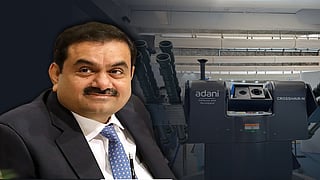Portfolio overlap in equity mutual fund schemes is unavoidable, but concentration in select stocks can be risky, according to experts.
Portfolio overlap in not a constant but a dynamic factor, Prableen Bajpai, founder of FinFix Research and Analytics, told BQ Prime's Niraj Shah.
"In times when schemes are doing fine, it is good. We want to add more and more from the same fund house. But when things don't work well—for example, we saw Axis struggle a bit—then what happens is that almost all the schemes from the same fund house are struggling," she said.
According to Kartik Shah, founder of MMY Investments, many of his clients chase new fund offers driven by the aggressive marketing pitch by asset management companies for funds that perform well in the short term.
"I have seen clients having 15-25 fund schemes, out of which 10 to 15 have duplication of 60% to 70%. That can be avoided and those funds need to be pruned," he said.
According to Shah, across segments, the overlap in schemes with mid-cap and small-cap stocks is not very high, even within the same fund house. However, such schemes don't get diversification in terms of style of management, he said.
Fund portfolio and diversification depends on the fund manager’s approach, said Shah. "So, at times, some fund managers have growth-oriented styles while others have high value investing styles. So, it makes sense to have a few fund schemes for proper diversification," Shah said.
Watch the full video here:
Edited excerpts from the interview:
Prableen, when you are advising your clients does the issue of overlap of the stocks behind the mutual fund portfolio assume significance?
Prableen Bajpai: So, I think that is one of the concentrations for sure while constructing a portfolio. I think the very idea of adding more schemes to portfolios based on the concept that you are able to diversify the portfolio and let's say by adding a greater number of schemes, you are actually giving the same exposure, the same stock exposure to the investor.
So, somewhere that purpose is defeated and you end up adding a number that goes up in the portfolio, the size of the portfolio becomes bigger. So definitely that is a concentration. But having said that, overlap is one of the little things that one needs to see because it is a factor which is dynamic in nature, and it won't be constant.
So, I think there has to be definitely, while creating a portfolio, while adding a new scheme or even investing in an NFO that has to be somewhere at the backdrop. But yes, am I adding a new PE or am I going to get the same exposure to sectors themes but to some extent, I think overlap is unavoidable and cannot be the only criteria but yes, it has to be checked while adding or creating a portfolio.
Kartik, do you look at the overlap?
Kartik Shah: We need to understand what we mean by a portfolio overlap. So basically, it is just not a number of stocks which are common between two funds. It is actually the weight of the stocks which is common. For example, two funds can have fewer stocks in common, but the allocation to those stocks is higher, then the overlap is also high. So, there are tools which are available.
First, the proper overlap has to be done when you are analysing a client's portfolio. The second point I want to make is first we can also discuss how do clients actually end up buying so many funds. Now, I have seen two reasons broadly when I meet my clients, one is endlessly chasing up NFOs that come, this is because of the aggressive marketing pitch by AMCs and the relationship managers through which they buy NFOs and second is at times they tend to chase the performing funds as in performing funds in the short term.
So, which are the top performing funds in the last one year, they try to chase them because of that they keep on adding funds without realising that duplication is happening or not and I have seen clients having 15-20-25 fund schemes, out of which 10 to 15 have duplication of 60 to 70%, so that can be avoided and those funds need to be approved.
Kartik, what is the higher overlap percentage?
Kartik Shah: According to me anything over 60 to 65 % is a higher overlap. Of course, there are categories in which overlap is inevitable. For example, in the large-cap fund space, overlap will happen, but even in large-cap funds I have seen overlap of around over 70% which is way higher.
Prableen, does that lead to something like this happening, especially for the DIY investor?
Prableen Bajpai: When I think we are constructing our portfolios and specifically our own selves, we are looking at the names. So, let's say an investor who has a large-cap fund is now looking to add a flexi-cap fund. I think in his opinion, he's making the right choice or she's making the right choice by adding a new category without realising that maybe the underlying stocks are very high in terms of the overlap.
I will give an example here, what often happens is that if you are comfortable with the fund house or you liked the performance of a particular AMC, I think you also tend to go in for another scheme from the same AMC. For example, the Quant tax plan and the Quant flexi-cap fund, both of them actually have a high overlap of about 75%. So, they have about 24 stock holdings, which are overlapping, and I think it's not the numbers, but the overall weightage wise, it's coming out today at about 75.
So, probably for someone who's actually looking to increase exposure to let's say, scheme from Quant and has the tax saver might as well increase the exposure there without adding the flexi-cap fund because he or she is going to have the same sort of investment philosophy, and the stocks are pretty much the same.
So, we feel that we are adding a different category, but you are going one step ahead and in checking the overlap is somewhere important and there is no drawback to it other than I think two major things. Number one, that your portfolio stops becoming quite huge because you are looking to diversify, but the diversification is not happening.
Secondly, the downside risks, what we call the concentration risk also, to some extent goes up and in times when schemes are doing fine, it's good we want to add more and more from the same fund house. But when things don't work well, for example, we saw Axis struggle a bit, then what happens is almost all the schemes for the same fund house are struggling, and that is also because of the common sort of investment philosophy and the stock universe that we usually invest from.
Prableen, that's a very common cause I would presume.
Prableen Bajpai: Yes, it is and that's okay. You can always have faith in a fund house. But then I think there the investors need to be careful and so let's say if I like HDFC, so it's okay if I am having HDFC top 100 and I am adding the mid-cap opportunities because of the overlap between those schemes, because of the very construct and the mandate requirements will not be very high.
But whenever we are adding or where we have the flexi caps, flexi-caps and large-caps usually that is where we are seeing the problem because flexi-caps have the freedom to move around across the market cap. So, because of the mandate requirements being different, I think these are the categories where we see a higher side overlap.
Otherwise, I think across the different segments, the schemes which are there mid cap, small cap, the overlaps are not very high, even within the same fund house although they don't get the diversification in terms of style of management.
Kartik, tell us a bit about this and why is this avoidable?
Kartik Shah: First of all, I think the more funds the client has it becomes difficult to manage and to track, so if the duplication is higher, the whole idea is to keep one fund and let go of the other. We are not saying that the funds are not good in there. So, let's say in the large-cap space, one of the examples was Canara Robeco blue chip and Mirae Asset large-cap has over 67% of overlap.
So now, the funds for companies which are not in common, the related outperformance of that is not going to change the current fund performance of either. So, it becomes prudent for the client to keep either of these two rather than having both and maybe invest the money in some different fund where the overlap is lesser.
I mean, like Prableen rightly mentioned there are categories where the overlap is lesser, so you might make the client invest in those categories with multiple funds to get us more diversification.
He allows his portfolio a chance for exposure to different markets, rather than just one particular market segment. I will just take another example of an AMC. Now, we have seen that in certain times the AMCs tend to favour certain stocks or certain stock segments. Now it is evident across market categories at times.
So, if you take Canara Robeco blue chip and Canara Robeco flexi cap, the portfolio overlap is around 77%. So, I mean there is no use keeping both the funds, rather reduce the fund and then take the money out and put it on some other fund. So, this is what I would say.
Kartik, what is the ideal number of schemes that you believe an investor should start with?
Kartik Shah: We are talking only about equity funds. So, I think to start off with two to three funds for the beginner is good enough. As he becomes a seasoned investor, like you said your viewers have that experience that six to eight fund schemes are good enough. An additional scheme needs to be introduced only if it is giving a diversification which is not available presently in the portfolio.
I will give you an example, let's say the investor does not have exposure to U.S. stocks, then it makes sense for him to go for Nasdaq and S&P 500 or if he is a high-risk investor and he feels that a particular segment or sector will do well then, he can go for a sector fund. But otherwise, according to me six to eight fund schemes are good enough.
Prableen, what would your views be?
Prableen Bajpai: So, I think if you are starting off with a clean slate, it's easy, you first start off with the three broader categories. Assuming that it's a long-term portfolio and risk appetite is towards high, you cover the large-cap space. Then you cover the mid-cap space, and then you cover the small-cap space.
So, just one fund from each of these categories and in the large and the mid-cap even a passive strategy can work and in the small cap, probably an active fund. So, there you will be sure that you are covering the broader markets, what the Indian stock markets are offering so that's one thing.
If you would have the appetite and are comfortable investing abroad, then you add another layer of diversification, like Kartik mentioned you can diversify geographically and add something like a Nasdaq 100 or S&P 500. That's another thing and then maybe a bit of gold. Even through mutual funds, I still feel that it's a good way if you are looking to invest a small amount on a regular basis.
So, you have the asset wise diversification also here and then you are having within equities the market cap fund diversification. I think there will be a very minimal sort of an overlap, maybe very little between the large cap, mid-cap and small-cap that would be more from the point of view of maintaining the liquidity.
If you are adding passive funds, they will have their own drawbacks in terms of missing out on the value approach. Gradually as the portfolio grows, maybe a fund with a little more value-oriented investment philosophy can be added.
Prableen, can one opt for multi-asset funds?
Prableen Bajpai: So multi-asset funds I think in itself an interesting concept because you are able to get the combination of all the different asset classes. I think it's able to contain the downside risk given that let's say, if the equities are not doing well and your composition of gold and fixed income is there definitely it'll hold on to the portfolio during downturns.
Having said that, it can still have a very high overlap with let's say, the remaining part of the portfolio if there is a more large-cap oriented portfolio for the investor because usually any multi-asset fund for the equity part of their holdings would have a primarily large-cap stocks, which is fine.
So, if you're looking at somebody who's going to have a multi-asset fund and has a moderate risk appetite, he or she can be comfortable with this one along with another large-cap and within the large-caps because to give an example, it's very interesting to see that the percentage of overlap is actually ranging from 20% to about 72% between the different large-cap funds. So, there are three to four large-cap funds also which have a very low overlap amongst themselves.
I think it is not just a given that you cannot add two schemes from the same category. I think one has to actually check when you are adding, what is the composition and it will just work for someone having even two large-cap funds or multi-asset with a large-cap if the overlap is not substantially high, and if it's good stocks and I mean, the comfort level is there, let's say if I am having Reliance Industries, HDFC as overlap, maybe I can continue.
Prableen, is the investor better off buying the passive Nifty fund?
Prableen Bajpai: Ideally, yes, ideally, absolutely. I think the problem is a lot of people already have active large-cap funds and now with the passives and all these discussions that we have, they want to add in another funds and then the duplication only goes up because the number of holdings is going up in terms of schemes.
So yes, if somebody is starting out like I mentioned, I think not only large cap, even in the mid-cap if you are on Nifty 150 can be picked for an investor who has a 15 to 20 years horizon very easily. It's a clean strategy.
Kartik, what are your views on this?
Kartik Shah: One point I just wanted to add, when an investor decides that he has enough duplication, how does he decide which fund to keep and which not to keep. So, three-four things he needs to see, so portfolio overlap in itself is not the only tool.
So, he has to check the performance against the benchmark, the performance against the category, standard deviation, how volatile that fund is, and how good the risk-adjusted returns are. So based on these metrics, he should be able to keep one fund and redeem the other, this is very important.
Kartik, are multi-asset funds or funds of that nature a good option for the person who doesn't have the time to kind of analyse what are the kinds of funds and what are the kinds of stocks within those funds?
Kartik Shah: My views are similar to Prableen’s that many of the multi-asset funds we see have a lot of large-cap concentration, so it makes sense for the investor also to invest in mid-caps and other categories.
One more point is that investing styles also differ. So, sometimes some fund managers have growth-oriented styles, some high value investing styles, so it makes sense to have few fund schemes, to give proper diversification.
 RECOMMENDED FOR YOU
RECOMMENDED FOR YOU

Maharashtra NEET Counselling Round 2 Selection List Out: Check Details
 Sep 25, 2025
Sep 25, 2025

Eternal Shares Hit Record Highs: What's Working And What's Not — A Deep Dive Into Company's Performance
 Sep 22, 2025
Sep 22, 2025

Adani Group Stocks Add Nearly Rs 69,000 Crore In Market Cap After SEBI's Clean Chit
 Sep 19, 2025
Sep 19, 2025

GST 2.0—The Big 'Antidote' To US Tariff Pain? Kotak AMC's Nilesh Shah Favours THIS Trading Move
 Sep 03, 2025
Sep 03, 2025


